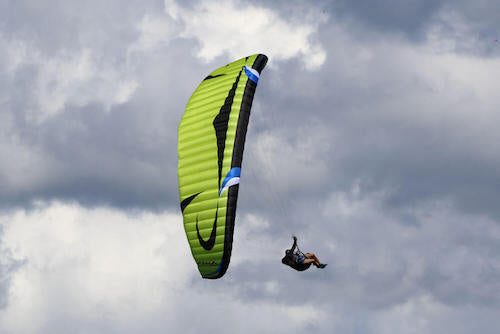Freedom 2 (High EN B)
Freedom2 – EN C performance in an EN B package!
Yes. Freedom2 offers unprecedented performance gains for the EN B class.
A glider packed with state-of-the-art tech.
- Hybrid 3-2 line layout
- Efficient rear riser steering
- Advanced shark nose airfoil
- 4 ways split A attachment point VPA (Variable pressure A-Attachment)
- Semi lightweight construction
Comfort in flight is paramount to flying a glider at its maximum and we took special attention to that.
Comfort in flight is only achieved with a combination of many factors, such as:
Pitch stability, airfoil solidity, easy and efficient rear riser steering, easy launching and good flare, good top-end speed, excellent glide, refined roll and bank in thermals, good feedback pressure through brake line and handles, light speed bar pressure and light and durable canopy.
We have addressed all those points in detail on the Freedom2.
An exciting and sporty package with EN B safety.
In addition to the hybrid 3-2 liner technology which reduces drag drastically offering huge gains in glide, Freedom2 also has a new shark-nose.
Unique for Freedom2, we are introducing a new 4 ways split-A 3D A-attachment point system.
Adding a new level of solidity and collapse resistance to the EN B class. We call it VPA (Variable pressure A-Attachment).
The new 4 ways A-attachment point enhances the structural stability of the leading edge keeping the AoA positive, even when the glider’s AoA is at negative angles. It’s a better solution geometrically and it also helps in sharing the forces more evenly throughout the leading-edge span. The increased solidity is noticeable, especially when gliding at speed in turbulent air.
The 3D A-Atchament point creates what we call VPA (Variable pressure A-Attachment). At trim speed, the pressure is more even in all 4 split attachment points.
When launching, during the pulling of the inflation phase, the pressure is at the very front lines of the “4-line split”. Resulting in quick and easy inflations.
It’s at a speed where the VPA really shines as it shifts the pressure to the rear lines of the “4-line split”.
The change in geometry turns the leading edge more stable as the new attachment points offer better structural support at those angles when inherently the leading edge is supposed to be “softer”.
It’s under that flying configuration (gliding with the speed bar applied) that we observe the most critical AoA and It’s right there where the VPA works at its best and that’s the reason the VPA was created. It aids the pressure shift to the rear lines of the “4-line split”. Mimicking the same solution given to higher-end gliders where the A attachment points are placed further back, which helps with the center-of-mass shift to the front lines, resulting in a stronger and more collapse resistance leading edge in lower AoA.
Freedom2 has a true racing pedigree with awesome handling and agility. It’s also an incredibly fun wing to fly.















